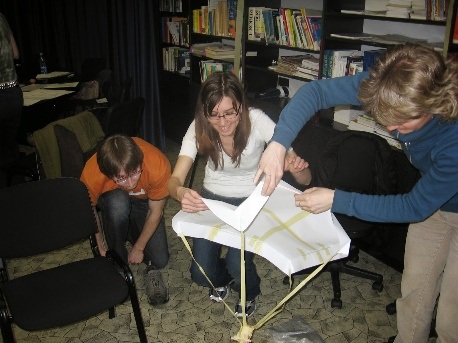Flying Eggs
Libor Štěpánek, Czech Republic
Libor Stepanek is Assistant Professor in English and Director of the Masaryk University Language Centre, Brno, Czech Republic. His international academic and teacher training experience include EAP, videoconferencing and intercultural communication, but his main academic interest lies in the Creative Approach to Language Teaching. He is also an active blogger (http://eapcreatively.blogspot.cz/). E-mail: libor.stepanek@cjv.muni.cz
Menu
Introduction
Activity setting
Task
Final comments
This seminar is inspired by a classic team-work activity. As a language seminar, it focuses on effective communication in creative situations. What we mean by a creative situation in this context is a type of situation that is based on uncertainty – participants cannot be sure whether a given situation has a solution or not.
GOALS: task-based learning; effective task-solution oriented communication; hands-on task-solution oriented communication; reflective communication
TIME: 90–120 minutes
Students work in groups of two or three. They are explained that their task is to drop a crude egg from a high place (three metres and more) so that it does not break at landing – the egg must land crude, complete, unbroken and uncracked. A successful landing is such where the egg shell touches the ground and remains unbroken or uncracked. To perform this task, students get some material to use and two eggs – one can be used for a test and the other is used to show the landing in front of an audience (and lecturer).
Each group has 500 points to work with and they can choose from different types of material.
In our sessions, we use the following material:
sheets of paper A4: 25 points per one sheet
sticky tape: 30 points per one metre
straws: 5 point per one straw
modelling clay: 50 points per one cube 1 x 1 cm
condoms: 100 point per one piece
candied lemon peel: 50 points per one tea spoonful

The only necessary material for a successful solution is paper and sticky tape. The aim of presence of all the other types of materials is to stimulate discussions in different parts of the session: (a) Straws and modelling clay can stimulate discussions focusing on various solutions of the problem; (b) condoms can be used not only for similar purposes (they can be turned into a flying balloon for the eggs), but also for reflection after the task (as some students may choose not to use condoms just because for what they are associated with); (c) and the candied lemon peel stimulates discussion in all possible directions as it has no use at all (at least, nobody has found any so far), still a great number of students take at least one spoonful just because they feel “if it is there, it must have some function”.
The instructions for the flight are:
- The minimum distance of any person from the egg-landing place is one meter, i.e. nobody can be catching the egg.
- No kind of rope, tape or lowering device touching the egg during its flight is allowed.
- The course lecturer shows the exact place where to drop the egg from.
- No living creature can form part of the flying construction.
- The completeness of the egg shell after landing must be observable (eye checked).
- The height (length) of any construction on ground cannot exceed 75 cm.
- The egg cannot be processed in any way (no boiling or freezing is allowed).

- Students discuss their strategies. They can only speak and take notes. Time: 10 minutes
- Students prepare and test the “flight”.
- They ask the lecturer for the material any time during this section (it means, they can first ask only for material that equals only some part of their 500 points and later for the rest);
- They start and try to construct and test what they previously discussed.
They can only use English for communication.
Time: 50 minutes
The “flight” is performed. The lecturer takes students to the place (usually some staircase or balcony, already prepared) where the eggs are to be dropped from. Then, one group after the other drops the egg. The lecturer checks after each “landing” whether it was successful or not.
Time: 15–20 minutes

This task brings in a lot of emotions because students are trying hard but do not know if they are going to succeed or not. This is why it is essential that the lecturer keeps turning the attention of students to language skills and communication processes; especially after the “flights”. Students usually tend to think this is a competition and focus on “who manages to fulfil the task”, but it is not a competition (the activity is a stimulus to communication) and the lecturer should be able to make this clear.
Reflection (Time: 15–30 minutes): After the “flight”, the lecturer takes students back to class, asks them to reflect on what was going on, take notes if necessary and finally discuss the activity and its results from different perspectives:
- personal feelings;
- choice of strategies;
- choice of the material used;
- quantity of the material used;
- team communication;
- results;
- consequences;
- anything else.
At the end of the session, the lecturer can summarise different types of communication students have been engaged in and some of their typical features:
- Language for planning: discussing ideas, bringing arguments for and against different solutions, negotiating
- Language for hands-on collaboration: students usually realise they do not have the vocabulary for “physical activities” and end up in using simple phrases, such as “here; like this, no, not like this; in this way; put this here, that there; etc.”
- Language for reflection: if the reflection is divided into separate topics, the lecturer can point out different means of communication that are used for different situations.

Please check the English Language Improvement for Teachers course at Pilgrims website.
Please check the English Language Improvement for Adults course at Pilgrims website.
Please check the Creative Methodology for the Classroom course at Pilgrims website.


|